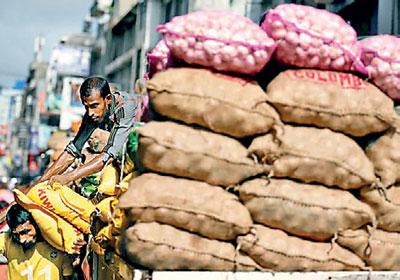04 Oct 2021 - {{hitsCtrl.values.hits}}
Prices measured by the Colombo Consumer Price Index (CCPI) eased in September from a month ago as months-long hyper increase in food prices slowed a bit, both from a month ago as well as from a year earlier levels, but authorities are confronted with fresh concerns over the fast pick up in non-food prices which could gather further momentum with the re-opening of the economy after a six weeks’ long less restrictive lockdown.
 CCPI, the mostly watched consumer price gauge for policy making rose by 5.7 percent in the 12- months to September 2021, decelerating from 6.0 percent from a month ago levels when the prices jumped to 18 months high on soaring food prices caused by several factors.
CCPI, the mostly watched consumer price gauge for policy making rose by 5.7 percent in the 12- months to September 2021, decelerating from 6.0 percent from a month ago levels when the prices jumped to 18 months high on soaring food prices caused by several factors.
Initial concerns of inflation started to emerge with virus related restrictions interrupted the domestic food supply chains from around May this year adding to the already high global commodities prices.
However, things took a turn to the worst by the subsequent foreign exchange shortage in the domestic market which created shortages of imported goods and led to step up prices of all imported goods, caused by the weaker rupee against the dollar.
Upward revision in fuel prices in response to the fast recovery in global crude and petroleum prices in June sparked a cascading effect on everything from food staples to transport to travelling to others.
However, September prices were driven less by food, energy and transport but other non-food items.
This was reflected by the core inflation which rose by 5.0 percent in the 12- months to September, which accelerated from 4.1 percent through August despite easing of the headline inflation in September which includes all items.
In September, food prices rose by 10.0 percent from a year ago, decelerating from 11.5 percent in August while the increase in Month-over-Month (MoM) prices too eased to 0.3 percent from 0.7 percent in August, perhaps reflecting the worst could be over in respect of what appeared to be a hyper-inflationary run seen in food staples.
The prices of rice also had a steep fall from their exponential levels at the tail end of the month after the government removed the controlled prices and simultaneously announced intentions to import 100,000 metric tonnes of rice despite record paddy harvest.
However, the paddy harvest, the main staple in Sri Lanka among other crops, is estimated to drop by 30 to 40 percent should the full ban on the use of chemical fertilizer and other agro-chemicals go into effect as the signs of agitation are already seen from the farmers across the country through rampant protests.
While sector experts aren’t in principle against the shift towards organic fertilizer use, they echoed their call to the government to take it slow in a phased out manner to prevent a ‘shock’ in the system as nobody challenges the need for safe and sustainable agriculture in Sri Lanka.
During September, prices of rice, sea fish, eggs, coconut oil, vegetables and a few others declined while prices of rice flour, bread, cake, chicken, dried fish, coconuts, fresh fruits, Mysoor dhal, big onions and a few others rose from August.
Meanwhile, the non-food prices rose by 3.8 percent in the 12- months to September, accelerating from 3.5 percent in August but what makes it more troubling is the MoM jump in prices which recorded at 0.6 percent compared to 0.1 percent in August even before the full re-opening of the country.
September prices were driven mainly by the LP gas, health related expenditure such as medicinal drugs, fees on private healthcare and ayurvedic practitioners and education related fees.
However, while there could be certain immediate to short term cost spikes due to need for re-adjustments, pandemic induced digital adoption across multiple sectors has the potential to reduce the prices across a variety of sectors as it leaves out daily commute by huge proportions which typically lead to heavier cost in the overall basket of non-food expenses.
Thus the pandemic induced new normal could in fact offset or at least mitigate any perverse effects from what the fuel price increase has had on people’s wallets and institutional cash flows, according to an economic analyst who closely watches the monthly price movements.
17 Nov 2024 7 hours ago
17 Nov 2024 9 hours ago
17 Nov 2024 17 Nov 2024
17 Nov 2024 17 Nov 2024
17 Nov 2024 17 Nov 2024